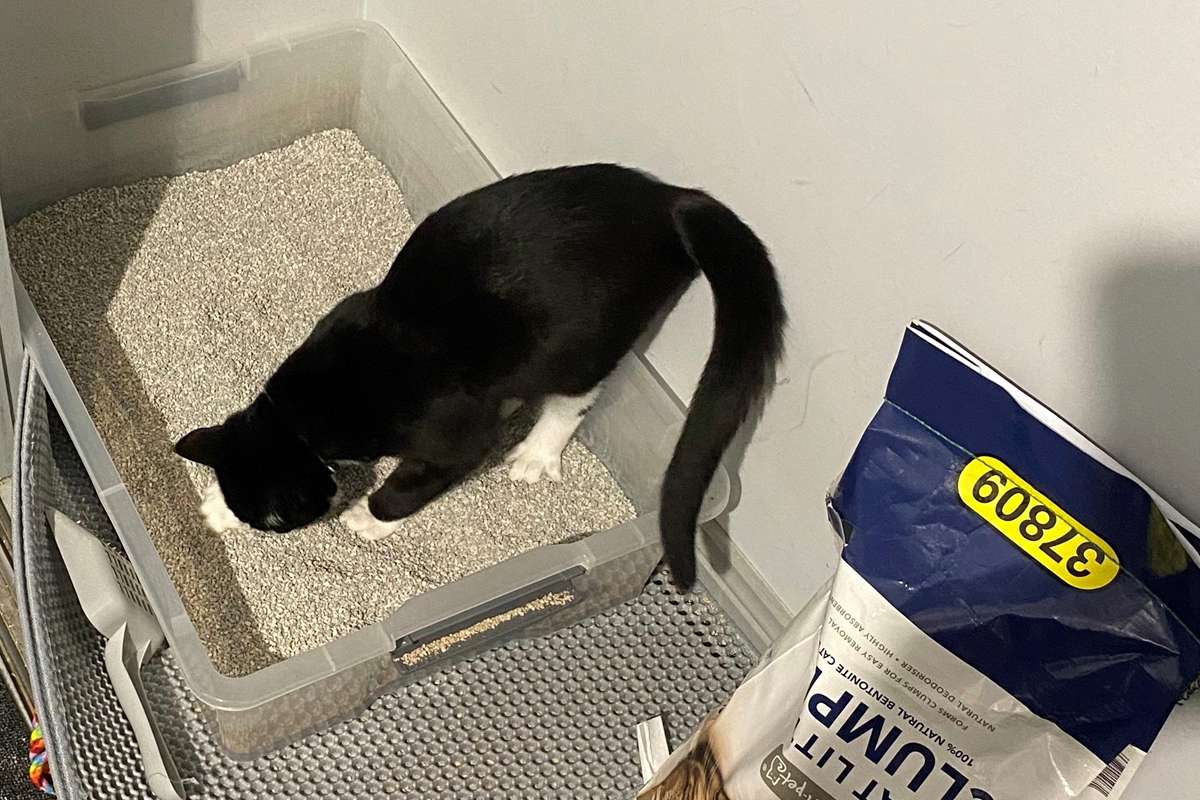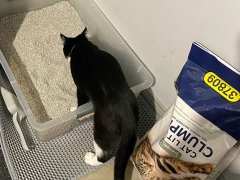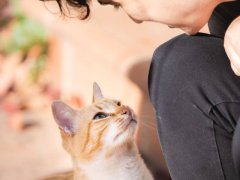
Melina Grin / Cats.com
Have you ever imagined adding potty training a kitten to your list of achievements?
Most cat owners assume kittens know intuitively how to use a litter box when they join our family, however, it isn’t always the case. Toilet training is the first thing you will need to teach your kitten!
Kittens learn how and where to eliminate by observing and mimicking their mother. If you rescued an orphan or adopted a kitten, you will need to take over the house-training process.
Ensure your kitten practices a lifetime of valuable bathroom habits by following below guidelines and learning essential litter box manners.
- Kitten Safe Litter- Use litter that is safe for kittens. Avoid clumping litter, certain kittens like to ingest (eat) litter and it can also get stuck onto a kitten’s face, nostrils, or other body parts. Research has demonstrated that cats prefer a fine granular of sand like texture. Other surfaces include a high quality, dust free, unscented clay litters (clay is most used plus some pellet-type litter). Shredded newspaper can also be utilised as an alternative.
- Substrate Choices- Kittens develop substrate (texture) preference about 4-5 weeks of age, choose a litter that appeals to your kitten or the same litter your kitten is used to when acquired. If you need to replace litter type, gradually introduce the new litter into the old one so your kitten gets used to it. Offer young kittens several litter< options as early positive exposure may likely influence acceptance of alternatives throughout life.
- Litter Depth- Litter depth should be one to three inches; some cats prefer less whilst kittens who like digging will want more, irrespective empty and clean the litter boxes daily, twice a day for fussy cats due to a cat’s strong sense of smell!
Box Size Significance

Kittens should use shallow litter boxes that are easy for them to enter and exit. Kate Barrington / Cats.com
Purchase multiple small litter trays with low edges (not higher than 2 – 3 inches) to ensure your petite-legged kitten can effortlessly climb in and out. Young kittens have limited mobility until they reach two months, so stick to a small tray. Large litter potty trays with high edges (four inches or above) or with hoods can be intimidating for certain little kittens.
For tiny kittens, the litterbox may need to be temporarily altered by using a small tray (i.e., cat-food cardboard box) until the kitten is big enough to access a commercial plastic or metal litter-box.
Litter Tray Location

Start litter training kittens by placing multiple litter trays in clean, empty corners of a kitten-proof room. Kate Barrington / Cats.com
Set up a kitten-proof room with multiple trays. Place the litter trays in corners that are clean, clutter-free, and easy to access – don’t expect kittens to travel far to use the litter tray.
If space is an issue, spread the litter containers (minimum 2 – 3) throughout the house, ideally at the edges of core areas where the kitten spends most of its time in a quiet, private place that is readily accessible.
Avoid noisy, high-traffic areas like kitchens and prevent disturbance by children plus pets. Trays should be located away from furnaces, air-conditioners, as well as loud electronic devices. Never place litter boxes near food or water bowls!
In multilevel homes, station few litter restrooms on each level. Don’t move trays since it may confuse your kitten companion.
Common Bathroom Problems
Watch for elimination problems such as diarrhea, constipation, straining, or crying.
Diarrhea is a common problem in kittens, especially kitties fed milk replacer.
Among kittens feed milk replacer, diarrhea may be due to over-feeding or an inappropriate milk replacer. Constipation is also widespread in kittens fed milk powder. If diarrhea or constipation is persistent before and after weaning, see your veterinarian as soon as possible. Weaning is a hectic period in a kitten’s life as outbreaks of diarrhea and disease are frequent.
To learn more about kitten care and nutrition head to How to Take Care of a Kitten: The Complete Guide
How to Litter Train a Kitten: Step-By-Step?

Once you’ve prepared the area, it’s time to start litter training your kitten. This process is usually easy, but there are a few things you should keep in mind before you start. Melina Grin / Cats.com
Successful litterbox training should start about 3-4 weeks old. Initially confine to a kitten-proof room with access to food, water, toys, bedding, and multiple latrines.
Step 1: Acclimation
When you bring your new kitten home; accompany him or her to the litter box and place them in the tray. Gently move their front paws through the litter to let them sense the texture. Use your forefinger to paw through the clean litter, then let your kitten explore the litter box while jumping in/out on their own.
Step 2: Litter Box Introductions
Throughout the first few days to a week; position them in the litter tray when he or she first wake-up, after eating, following a play session and later when they wake up from a nap.
After positioning him or her in the potty, quietly step back and leave him or her to do their business. Most cats prefer privacy and don’t wish to be disturbed, you can praise them once they accomplished the goal and away from the toilet.
Generally, place the kitten in the tray after each meal, whenever you see them squat, put him or her in the tray. If your kitten attempts to move away, pick them up and situate back in the tray. Don’t rub the kittens face, punish, yell, or squirt with water. Your kitten may become frightened and avoid the bathroom all together.
Step 3: Be Patient!
It is normal for young kittens to have toileting accidents outside the box during this exercise, please be patient, persistent and clean the mess with an enzyme odour neutraliser. To encourage use of the tray, place a poop nugget inside and mimic the scratching behaviour with your fingertips.
If they are still struggling, give them a treat after each use (treats should be faded once fully weaned). Transition the trays to the rest of the house once the kitty is fully trained.
Remember, cats are exceptionally clean but fastidious animals. Kittens usually quickly adapt to learning how to use a litter tray with praise. Punishment is often ineffective and confusing for kittens and adult cats.
Use positive reinforcement when your kitten or cat utilises their latrines. This will teach them to learn that using the litter-trays gets treats, play, love, and attention.
Frequently Asked Questions:
What is the fastest way to litter train a kitten?
The quickest way is to purchase 3 – 4 small litter trays, position latrines in several places in a kitten proof room and place your kitten in the tray after eating each meal to promote use.
How long does it take to train a kitten to use the litter box?
Even though it’s an instinctive behavior learned from watching their mothers, some kittens will need a little help when they join our household. Most will catch on instantly while others will need to be placed in the litter tray several times a day for weeks. Overall, it can take up to four weeks to be fully trained.
How do you litter train a kitten without its mother?
Kittens voluntarily eliminate urine and faeces about 3 - 4 weeks of age. Orphans younger than 3 weeks require their genitals stimulated after each meal to induce defecation and urination since it’s usually invigorated by their mother.
To help a neonate eliminate: before and after a feed, moisten a cotton ball or damp soft cloth with warm water and gently rub his or hers tummy as well as genital area in a circular motion until the kitten urinates and defecates (similar to how the queen grooms kittens). Kitten will urinate during each stimulation and usually defecate once daily. See your vet for additional advice.
Why won’t my kitten bury their poop?
Many cats will only partially bury their faeces or won’t bury them at all especially in a new home range or territory since poop is a form of communication; stool pheromones transmit detailed information about the cat’s age, health and sexual status. In the wild cats may hide scent so predators won’t find them or leave it uncovered to declare their territory.
Certain cats do NOT bury urine or stools at all proving it difficult to train.
If your kitten is reluctant to bury their poop, encourage concealment by digging with your fingers or gently using your kitties’ paw to mimic the queen’s behavior while kitty is inside the tray. If that doesn’t work, try changing the litter tray or type.
Why won't my kitten use the litter box?
There could be several reasons your kitten won’t use the litter box:
Tray size - perhaps the tray size isn’t right for your kitten; too small kitty could miss the tray; too large kitty might not be able to get inside.
Litter box aversion – there could be both medical and behavioural causes. Kittens and adult cats may dislike the tray, the litter, substrate, location of the box or all combined.
Dirty litter - a cat’s sense of smell is stronger than humans as their urine has a high concentration of ammonia. Numerous kittens and cats won’t return to dirty litters whilst too clean of a litter box may leave a chemical residue. Be sure to scoop out deposits daily. Clean and wash it weekly with soap and water.
Stress – anxiety may also be a factor specifically when moving to a new home, reduce stress with the aid of a calming diffuser.
Medical issues – toileting outside the litter tray may indicate a medical problem. Kittens are susceptible to urinary tract infections and other illness that need to be investigated and treated by a vet immediately.
-
Consultant, I. A. (2019). Your Cat and Litterbox Chat: The Prevention of Litterbox Problems. USA. Retrieved November 16, 2020, from http://www.iaabc.org/
-
Dale, S. (2019, March 8). Swaying Cats to Aim Into the Litter Box. Retrieved November 17, 2020, from Steve Dale Pet World: https://www.stevedalepetworld.com/blog/swaying-cats-to-aim-into-the-litter-box/
-
Heath, I. R. (2016). Feline Behavioral Health and Welfare. St Louis, MO: Elsevier. Pg 80. Retrieved November 19, 2020
-
Little, S. (2013). Playing mum: Successful management of orphaned kittens. Journal of Feline Medicine and Surgery, 15, 201-210. Retrieved November 15, 2020
-
Moore, A. (n.d.). Litter Box Lessons. In H. P. Nutrition, Cat Behavior Book (pp. 20 - 24). Veterinary Ventures, Inc. Retrieved November 17, 2020
-
NSW, C. P. (2016). Litter training. (C. P. Society, Compiler) Newtown, NSW, Australia. Retrieved November 19, 2020, from www.catprotection.org.au
-
NSW, C. P. (2016). Your New Cat. (C. P. Society, Compiler) Newtown, NSW, Australia. Retrieved November 17, 2020, from www.catprotection.org.au
-
NSW, C. P. (n.d.). Orphan kittens – considerations and care. Newtown, NSW, Australia. Retrieved November 16, 2020, from www.catprotection.org.au







